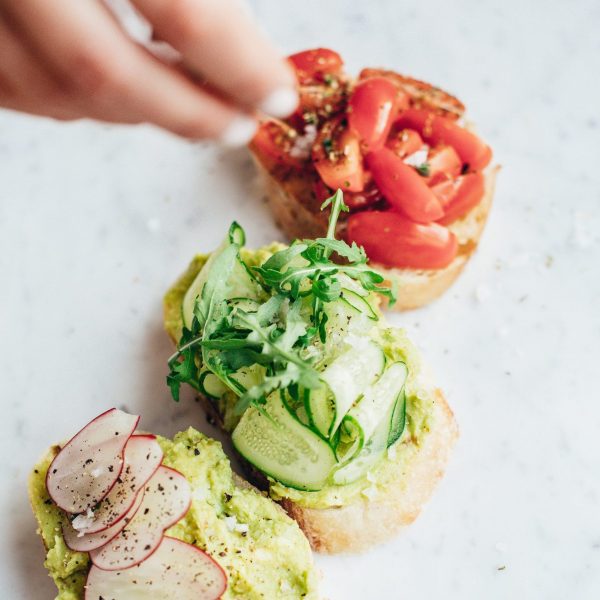We know you are trying hard to stick to eating healthy while preparing for pregnancy. You know you are doing a pretty good job – most of time, right? It can be a little tricky trying to follow the fertility diet when first starting out, but with recipes like the one I am about to share, your taste buds and body will be craving these fresh, nutritious ingredients in no time.
Each year in the Spring when planting my garden, I sprinkle parsley seeds in the last little corner where nothing else seems to want to grow. I inevitably get a huge bunch of parsley to grow. I am then presented with a lush green bunch of parsley leaves and left wondering what to do with them. I dehydrate some for seasoning food dishes through Fall and Winter, but know how healthy parsley is to eat fresh too.
So, this year I decided to create an easy Tabbouleh recipe in which I can use some of my garden’s end-of-summer bounty – parsley, cucumber and tomato. You won’t be hard pressed to find a number of uses for cucumbers and tomatoes, but what isn’t common knowledge is that each of these ingredients have the potential to benefit fertility health.
Tomato and Parsley and Cucumber – Oh My!
Parsley (Petroselinum crispum)*: a warming, bitter herb rich in antioxidants known to strengthen the adrenal glands, aid digestion, flush the kidneys, and promote blood flow to the reproductive organs which may be useful for those with amenorrhea and irregular menstrual cycles.
Parsley contains the nutrients:
- vitamin C (it contains more than many citrus fruits)
- vitamin K
- provitamin A
- chlorophyll
- sodium
- just 1 ½ ounces contains 80 mg of calcium
- magnesium
- iron
Fun Food Fact: Parsley freshens breath. Chew a sprig for many more health benefits than a breath mint.
Tomato (Lycopersicon lycopersicum): This is the one fruit that most people refer to as a vegetable. Tomatoes are cooling and drying, tonifying to the liver, detoxifying to the body in general, and they encourage digestion.
Tomatoes contain:
- lycopene and quercetin
- vitamin C (concentrated in the jelly-like substance surrounding the tomato seeds)
- potassium
- vitamins E and A
- zinc and folic acid
Tomatoes are best consumed raw although can be irritating for those with arthritis.
Fun Food Fact: Thin slices of raw tomato can be applied externally to move stagnation within the body, under the area where applied.
Cucumber (Cucumis sativus): Cucumbers are cooling for inflammatory conditions, sweet, and diuretic, they counteract toxins, cleanse the blood, quench thirst and are cooling and purifying to the skin, making them useful externally for cyclic acne.
Cucumbers are most notably calorie-free, but contain a few nutrients, including:
- vitamins A, C, E
- potassium
- beta-carotene
Fun Food Fact: A cucumber’s bitter skin is rich in silicon, chlorophyll, and folate. A tea of cucumber skin can be used for swelling of the hands and feet.
Homemade Tabbouleh
Ingredients:
1 box whole wheat Couscous – cooked as directed and cooled
2 small tomatoes, seeded and diced
2 small cucumbers, diced
1 large bunch parsley, stems removed and leaves chopped finely (I grow flat leaf parsley)
Dressing: Mix and set aside in a Mason jar or glass container with a lid.
- ¼-½ cup Extra Virgin Olive Oil (EVOO)
- 1 tsp. Himalayan pink salt
- ½ tsp. black pepper
- juice of one lemon
Directions:
Cook couscous or whichever grain you choose and allow to cool. When cool, add cucumber, tomato, and parsley and drizzle the dressing over it all. Mix and serve in whole grain pita bread pockets or bib lettuce leaves, with extra lemon wedges on the side.
Include as much or as little tomato and cucumber as you wish. This recipe is complementary to a Fertility Diet, especially while completing a Fertility Cleanse. Enjoy! Feel free to share if you try another grain in place of the couscous as well. I was thinking of trying millet next time.
*Caution: Not to be consumed in pregnancy in high amounts as it is a uterine stimulant, or while breastfeeding. Not to be consumed in excess by those with kidney, bladder or gallbladder inflammation without first consulting a healthcare provider.
- Pitchford, P. (2002). Healing with whole foods: Asian traditions and modern nutrition (3rd ed.). Berkeley, Calif.: North Atlantic Books.
- Haas, E., & Levin, B. (2006). Staying healthy with nutrition: The complete guide to diet and nutritional medicine (21st-century ed.). Berkeley: Celestial Arts.





